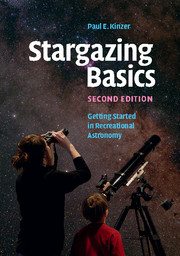Book contents
- Frontmatter
- Dedication
- Contents
- Acknowledgments
- Preface to the second edition
- Introduction: why another stargazing guide?
- Part I Stargazing techniques and equipment
- Part II What's up there?
- Part III A stargazing glossary
- Appendix 1 the Greek alphabet
- Appendix 2 the constellations
- Some simple star chart
- Index
- Plate section
Appendix 2 - the constellations
from Part III - A stargazing glossary
Published online by Cambridge University Press: 05 August 2015
- Frontmatter
- Dedication
- Contents
- Acknowledgments
- Preface to the second edition
- Introduction: why another stargazing guide?
- Part I Stargazing techniques and equipment
- Part II What's up there?
- Part III A stargazing glossary
- Appendix 1 the Greek alphabet
- Appendix 2 the constellations
- Some simple star chart
- Index
- Plate section
Summary
Below is a table showing all 88 of the constellations recognized by the scientific community of the world today. The table also shows how to pronounce the names and what the constellations are often called in English. They are not always direct translations; Cassiopeia is the name of a particular mythical queen, not just a word meaning “queen.”
The entire sky is divided into 88 jigsaw-like pieces, and these are the names that go with those pieces. Most of the constellations are very ancient and refer to mythological creatures, gods, and heroes; often very strange to us now (what, for instance, is a sea goat?). But many of the constellations were created much later, by some of the first European astronomers to travel far enough south to see new stars (new to them, at least) and shapes made by those stars. The shapes they saw and named were then put on charts and accepted by astronomers at the time. They have since come down to us and are now official. Oddly, many of these shapes are also named for things obscure to us now, especially those named (rather unimaginatively) after scientific instruments of the time. (What, exactly, is an octant, and how do you use it?)
I should also say that some of the constellations are very dim, with not a single bright star. Many of these (for example: Lynx, Camelopardalis, and Antlia) were created in later years just to fill in the gaps between the brighter spots in the sky. A few, like Cancer and Equuleus, are ancient.
- Type
- Chapter
- Information
- Stargazing BasicsGetting Started in Recreational Astronomy, pp. 147 - 150Publisher: Cambridge University PressPrint publication year: 2015



